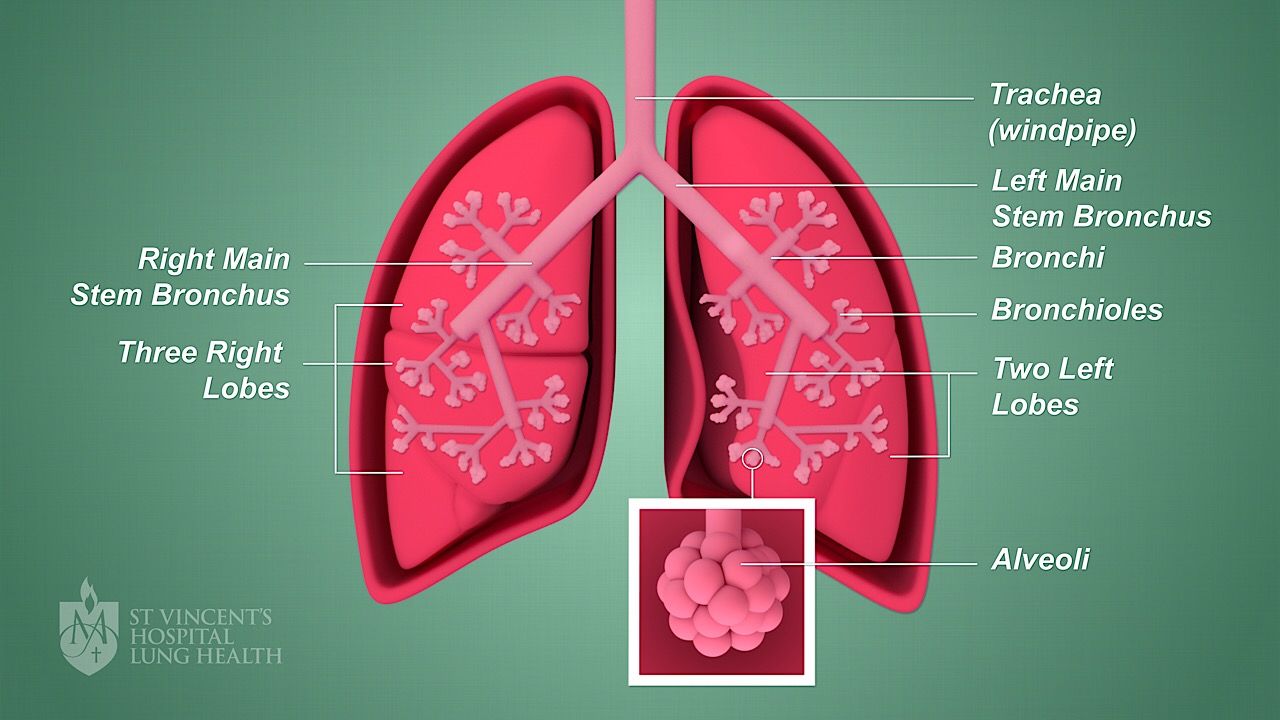Your Lungs
The lungs are a pair of air filled organs in your chest that allow you to breathe in fresh air and get rid of stale air.
What are the lungs?
What is the respiratory system?
What happens when you breathe?
What happens if your lungs have a problem?
How can I keep my lungs healthy?
What are the lungs?
Your lungs are a pair of organs that sit in your chest, behind your ribs. Together, the lungs are one of the largest organs in your body.
Your left lung is slightly smaller than your right lung to allow for space for your heart. The right lung has three lobes and the left lung has two lobes.
On the inside, lungs look like sponges and are filled with air. You can feel the full power of your lungs when they expand as you breathe in.
The lungs are a part of your body’s respiratory system.
What is the respiratory system?
The respiratory system is the group of organs and tissues that help you breathe. The respiratory system includes:
- Alveoli – millions of tiny air sacs at the end of the bronchioles, where oxygen and carbon dioxide are exchanged
- Bronchial tubes – your trachea divides into two bronchial tubes which pass air to each of your lungs
- Bronchioles – the bronchioles are like small ‘branches’ which carry air from the main bronchial tube to the alveoli
- Capillaries – the small blood vessels which surround the walls of the alveoli; oxygen is released from the alveoli across the wall into the capillaries and carbon dioxide is released from the capillaries into the alveoli
- Nose, mouth and throat – you breathe in air through your mouth or nose; air then passes through your throat and into your windpipe
- Sinuses – air spaces in the facial bones above and below your eyes that produce mucus to protect the nose from irritants
- Windpipe – also called the trachea, this is the tube at the back of your throat that leads to your lungs via the bronchial tubes.
The image below shows parts of the lungs. (Click image to enlarge)

As well as helping you breathe, your respiratory system prevents dust, germs and other harmful substances in the air from entering the lungs.
Your respiratory system also helps support your nose and sense of smell.
When you breathe, your respiratory system ensures that air is the right temperature and humidity level for your body.
What happens when you breathe?
When you breathe:
- Air flows through your nose or mouth to your windpipe and into the left and right bronchi
- The bronchi branch into smaller tubes called bronchioles
- At the end of the bronchioles there are millions of little sacs, full of air, called alveoli
- The alveoli have a very thin (only one cell thick) wall that allows oxygen to be passed into the small blood vessels, called capillaries, and into the blood cells
- In return, carbon dioxide is released as waste from the blood cells into the capillaries and into the alveoli
- When you breathe out (exhale), carbon dioxide travels through the bronchioles, up the bronchi, up the windpipe and out the nose or mouth into the air
- This process repeats and fresh oxygen comes back into your lungs when you take your next breath.
What happens if your lungs have a problem?
There are many factors that can impact your breathing and cause problems with your lungs and respiratory system, including:
- Asthma – if your airways become narrowed due excessive responsiveness to allergens or a sensitivity, you may have periodic trouble breathing
- Blood clots – a blood clot in the lung is called a pulmonary embolism and this can occur after surgery or if you are inactive for long periods of time
- Infections – bronchitis and pneumonia are common lung infections that can occur if germs and harmful substances aren’t trapped by your respiratory system as you breathe in
- Scarring – your lungs can become scarred for many reasons, some of which are not fully understood
- Smoking – cigarette smoke damages your lungs and causes serious diseases like COPD and lung cancer.
How can I keep my lungs healthy?
It’s important for people of all ages to prioritise their lung health. Many lung diseases can be long-lasting and difficult to get rid of, so prevention is the best strategy. Here’s how you can keep your lungs healthy as you age:
- Avoid air pollutants – ongoing exposure to pollutants in the air, such as chemicals, mould, dust and pesticides, can lead to chronic lung diseases; be sure to ventilate your home and work spaces, and wear protective clothing if you work with chemicals
- Avoid second-hand smoke – second-hand smoke is harmful to non-smokers, so avoid smokers and smoking areas
- Don’t smoke – smoking is a known cause of lung disease, so if you smoke it’s time to quit; phone 13QUIT to get started (it’s never too late to quit)
- Seek advice early on – many lung conditions respond well to early diagnosis and treatment, so if you’re concerned about your lungs, or have a history of lung disease in your family, visit your doctor for a lung health check up
- Vaccinations – keep your Influenza and Pneumococcal vaccines up to date and speak with your doctor about your risk status
- Wash your hands regularly – washing your hands prevents the spread of diseases that cause lung infections.